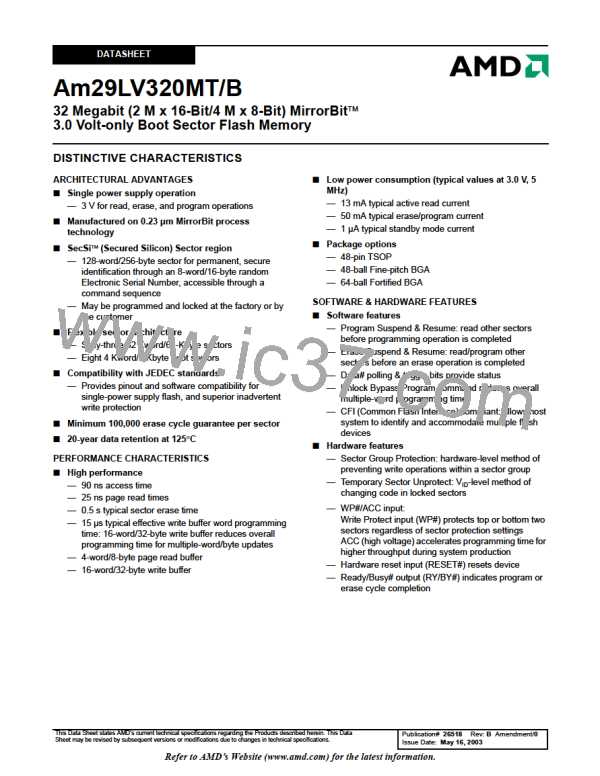D A T A S H E E T
DQ2: Toggle Bit II
The “Toggle Bit II” on DQ2, when used with DQ6, indi-
cates whether a particular sector is actively erasing
(that is, the Embedded Erase algorithm is in progress),
or whether that sector is erase-suspended. Toggle Bit
II is valid after the rising edge of the final WE# pulse in
the command sequence.
START
Read DQ7–DQ0
DQ2 toggles when the system reads at addresses
within those sectors that have been selected for era-
sure. (The system may use either OE# or CE# to con-
trol the read cycles.) But DQ2 cannot distinguish
whether the sector is actively erasing or is erase-sus-
pended. DQ6, by comparison, indicates whether the
device is actively erasing, or is in Erase Suspend, but
cannot distinguish which sectors are selected for era-
sure. Thus, both status bits are required for sector and
mode information. Refer to Table 14 to compare out-
puts for DQ2 and DQ6.
Read DQ7–DQ0
No
Toggle Bit
= Toggle?
Yes
Figure 9 shows the toggle bit algorithm in flowchart
form, and the section “DQ2: Toggle Bit II” explains the
algorithm. See also the RY/BY#: Ready/Busy# sub-
section. Figure 21 shows the toggle bit timing diagram.
Figure 22 shows the differences between DQ2 and
DQ6 in graphical form.
No
DQ5 = 1?
Yes
Read DQ7–DQ0
Twice
Reading Toggle Bits DQ6/DQ2
Refer to Figure 9 for the following discussion. When-
ever the system initially begins reading toggle bit sta-
tus, it must read DQ7–DQ0 at least twice in a row to
determine whether a toggle bit is toggling. Typically,
the system would note and store the value of the tog-
gle bit after the first read. After the second read, the
system would compare the new value of the toggle bit
with the first. If the toggle bit is not toggling, the device
has completed the program or erase operation. The
system can read array data on DQ7–DQ0 on the fol-
lowing read cycle.
Toggle Bit
= Toggle?
No
Yes
Program/Erase
Operation Not
Complete, Write
Reset Command
Program/Erase
Operation Complete
However, if after the initial two read cycles, the system
determines that the toggle bit is still toggling, the sys-
tem also should note whether the value of DQ5 is high
(see the section on DQ5). If it is, the system should
then determine again whether the toggle bit is tog-
gling, since the toggle bit may have stopped toggling
just as DQ5 went high. If the toggle bit is no longer
toggling, the device has successfully completed the
program or erase operation. If it is still toggling, the de-
vice did not completed the operation successfully, and
the system must write the reset command to return to
reading array data.
Note: The system should recheck the toggle bit even if
DQ5 = “1” because the toggle bit may stop toggling as DQ5
changes to “1.” See the subsections on DQ6 and DQ2 for
more information.
Figure 9. Toggle Bit Algorithm
The remaining scenario is that the system initially de-
termines that the toggle bit is toggling and DQ5 has
not gone high. The system may continue to monitor
the toggle bit and DQ5 through successive read cy-
cles, determining the status as described in the previ-
ous paragraph. Alternatively, it may choose to perform
36
Am29LV320MT/B
May 16, 2003

 AMD [ AMD ]
AMD [ AMD ]